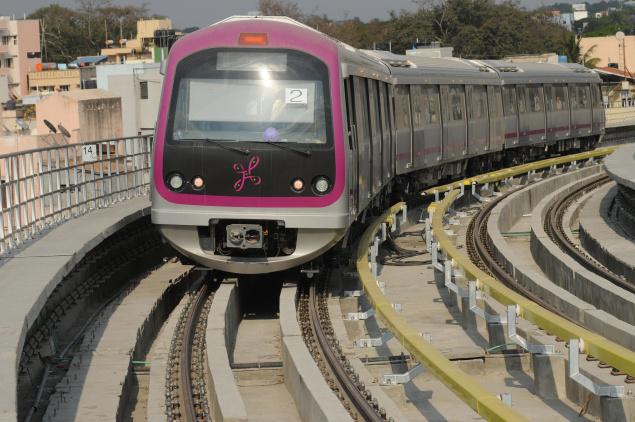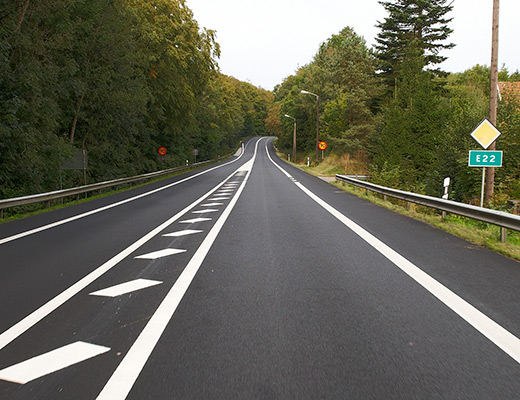
Why No Stones on Metro Track?
You might have observed that stones are laid beside railway tracks but
when it comes to metro tracks,there are no stones laid near the track.We
will discuss the reason for this in this article.
Let us first discuss why stones are placed near the railway track.The crushed stones you see alongside railroad tracks are what is known as ballast. Track ballast is packed between the sleepers, in the areas below, and on the sides of railway tracks. A railway sleeper is a rectangular support that is usually kept perpendicular to the tracks. The ballast distributes the load of the sleepers (which in turn bear the load of the train on the track, held by clips) across the foundation, allows for ground movement, thermal expansion and weight variance, allows rain and snow to drain through the track, and prevent the growth of vegetation that would quickly take over the track.
When it comes to metro track,it uses ballast less track.Ballast less tracks have different designs to absorb the vibration.They have high initial costs but less maintenance costs. That is why their whole life cost is lower than ballasted tracks.
Since the metro tracks are elevated, drainage and growth of vegetation aren't much of an issue, and the solid structure are designed to bear the wheel loads, and transmit them safely to the earth, there is no requirement of using ballast underneath the track.
There are safety & maintenance issues as well for using ballasts on the elevated sections, as they do pose the risk of flying off and hitting people using the space in the vicinity of the viaducts.
Another reason is that speed is very limited in metro as stations are very close ,that is why impact load is less (for which ballast is used).
Why Railways use ballasted track?
1.Ballasted track is good in the normal speed railway and fast speed railway.
2.Ballasted track requires low investment cost.
3. Ballasted track is usually easy to lay.
4.Ballasted track has good drainage performance.
5.Non-ballasted track cannot be laid in some area like clay deep cutting.
Nevertheless, whenever Rapid transit systems run on the ground, they use traditional methods of load distribution involving sleepers and track ballasts because they are much economic as compared to constructing reinforced concrete girders at places where the latter are not required. Such examples can also be found in Delhi Metro. At sections near Yamuna bank station on blue line, Delhi Metro runs on the ground and uses traditional track ballast.
Let us first discuss why stones are placed near the railway track.The crushed stones you see alongside railroad tracks are what is known as ballast. Track ballast is packed between the sleepers, in the areas below, and on the sides of railway tracks. A railway sleeper is a rectangular support that is usually kept perpendicular to the tracks. The ballast distributes the load of the sleepers (which in turn bear the load of the train on the track, held by clips) across the foundation, allows for ground movement, thermal expansion and weight variance, allows rain and snow to drain through the track, and prevent the growth of vegetation that would quickly take over the track.
When it comes to metro track,it uses ballast less track.Ballast less tracks have different designs to absorb the vibration.They have high initial costs but less maintenance costs. That is why their whole life cost is lower than ballasted tracks.
Since the metro tracks are elevated, drainage and growth of vegetation aren't much of an issue, and the solid structure are designed to bear the wheel loads, and transmit them safely to the earth, there is no requirement of using ballast underneath the track.
There are safety & maintenance issues as well for using ballasts on the elevated sections, as they do pose the risk of flying off and hitting people using the space in the vicinity of the viaducts.
Another reason is that speed is very limited in metro as stations are very close ,that is why impact load is less (for which ballast is used).
Why Railways use ballasted track?
1.Ballasted track is good in the normal speed railway and fast speed railway.
2.Ballasted track requires low investment cost.
3. Ballasted track is usually easy to lay.
4.Ballasted track has good drainage performance.
5.Non-ballasted track cannot be laid in some area like clay deep cutting.
Nevertheless, whenever Rapid transit systems run on the ground, they use traditional methods of load distribution involving sleepers and track ballasts because they are much economic as compared to constructing reinforced concrete girders at places where the latter are not required. Such examples can also be found in Delhi Metro. At sections near Yamuna bank station on blue line, Delhi Metro runs on the ground and uses traditional track ballast.

No comments:
Post a Comment